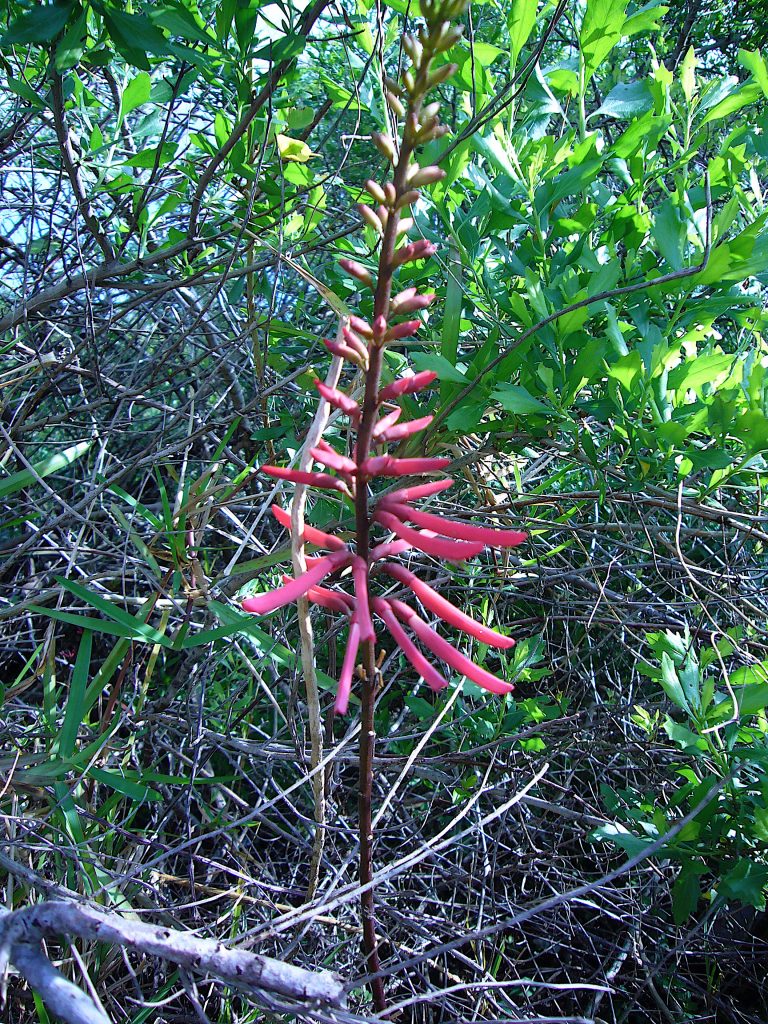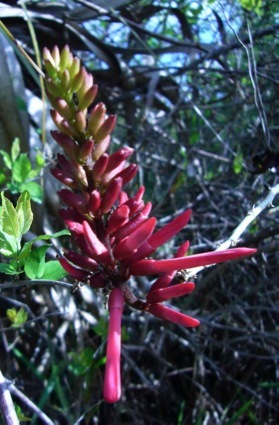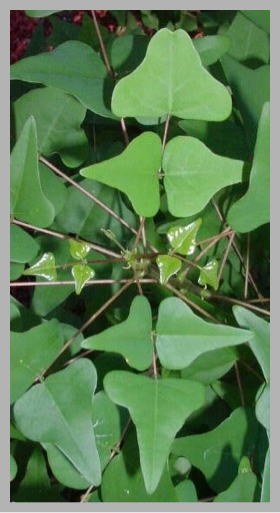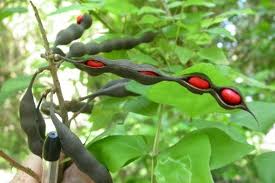
The Eastern Coral Bean is easy to spot this time of year. Photo by Green Deane
Erythrina herbacea: Part Edible, Part Not
The (eastern) Coral Bean is one of those damned if you do, and damned if you don’t kind of species. Parts of it are edible, parts of it are toxic, narcotic and hallucinogenic. So there is a trade off: Very easy to identify, but harvest carefully.
The boiled flowers and young leaves are edible, cooked like string beans but in more water. This semi-toxic plant is also quite healthy. A Japanese study published in the Journal of Natural Medicines, 29 Jan 2008, confirmed five antioxidants in the coral bean flower and found a sixth antioxidant. I boil mine for 15 minutes in plenty of water. They turn green and limp when cooked and reduce in size so collect a lot. The flavor is mild, like young spinach.
Coral Bean is a plant of the old South and into Mexico. But, it can grow not only across the southern tier of the United States but up the east coast to Maryland and up the west coast to Washington state. Out hiking it is always very easy to spot though in the wild it is rarely more than a spindly bush. However most people know the coral bean as a landscape plant and under cultivation and ideal conditions can reach 25 feet.
It is one of those odd thing in the plant world that people interested in plants tend to view them three basic ways. One is the agriculturist who views them as a commodity. There are those like foragers who tend to land on the nature side of things. They want to know where does it grow and can it be eaten. Then there are those who view plants like artistic elements to be put in a living canvas, the landscaped garden. I have a close friend like that. His property is as disciplined as mine is feral. He knows probably not a botanical name, nor which leaf he can eat, yet he’s a good husband of his plants and his yard a thing of beauty. He works very hard at it.
A coal bean to him would be a bit of color, and color over time because a landscaped garden is an interplay of plants as the season progresses. To an agriculturist the coral bean is a source of costly contamination, especially the seeds. It is a weed, weeds cost money and they are thus called noxious and must be dealt with as some enemy. To me it is something to add to the herb pot if it is shy on content. And I suppose there is a fourth group that includes most people. They ignore plants even though their lives depend on them.
The coral bean is an interesting plant for many reasons, one of which is that it always turns it leaves towards the sun. Each petiole has three uterine-shaped leaves, two on short stems but all three stems have the ability to turn the leaf. And you will notice unlike most trees and more like an herb, the smaller leaves are in the middle. Those are the edible young leaves, and of course, the red blossoms, both cooked. The seeds are NOT edible. They have been used for beads, however, and played an important religious role for the Aztecs in auguring the future. In tiny amounts the seeds are said to be hallucinogenic.
As for the toxin, it is not great according to the data base of the state of North Carolina. It varies from according to age, weight, physical condition and individual susceptibility. Most of the reports involve kids eating the scarlet seeds. In Mexico the seeds are used to poison rats, dogs and fish. It is similar to curare and hypnotic. That the flowers and leaves are edible is confirmed by no less august authority than Dr. Julia Morton, who for most of her life was the final say on toxic plants in warm climates, such as Florida. In fact, she is one of the experts that authored the edible plant portion of the U.S. military’s survival guide. I like the flowers. Boiled they are a mild in flavor.
The flowers of the Erythrina flabelliformis (fla-bel-ih-FOR-miss, fan shaped) are reported as edible — very favored in Mexico — but I have not tried them.
As for the botanical name of the coral bean, Erythrina herbacea (air-rith-RYE-nuh hur-BAY-see-uh) …There are about 112 species in the genus Erythrina, which comes from the Greek word ερυθρος which means red. The species name, herbacea in Latin means “grass, low growing, not woody.” It was named that because this particular plant is more herbaceous than others in the genus. Many of the plants in the genus are well-known and used in the tropics and subtropics as street and park trees. Some are used as shade trees for coffee or cacao and can grow to a hundred feet high. In most of its range in the United State the Coral Bean is a bush. The common name might come from the fact the flowers are shaped like a form of red coral. It is also called the Cherokee Bean, who used a decoction of the root for various purposes including kidney and urinary blockage.
Besides brilliant color the Coral Bean’s second claim to fame is that it’s fast food for humming birds. They were made for each other and one of the quickest way to get hummers to your yard is to grow a Coral Bean, just keep the seeds away from the kids. Humming birds, by the way, follow routes, kind of like air corridors called traplinings, (for next time you’re playing scrabble….
Other known edibles in the genus include E. americana, E. berteroana, E. fusca, E. rubrinervia, and E. veriegata.
Green Deane’s “Itemized” Plant Profile
IDENTIFICATION: Bush, three to sixteen feet,compound, uterine-shaped leaves lost in winter in cooler areas, kept in warm areas, herbaceous, bushy, can survive a lot of trimming. Stems have small, curves prickles, as do leaves. Flowers on leafless spikes in early to early summer depending upon the latitude, young leaves throughout the growing season. Easily blooms in February in Florida. Occasionally blossoms in fall. In dry areas can keep blossoms after leaves have fallen
TIME OF YEAR: Broken shade, sandy woods, hardwood hammocks, dry coastal tidewater areas, roadsides
ENVIRONMENT: Usually an understory plant among other bushes. But I’ve also seen it grow in full sun. Become less common due to destruction of habitat.
METHOD OF PREPARATION: Boil young leaves and blossoms in ample water. Whether the blossoms are edible raw is a bit of a debate with one authority quoting another in a questionable reference saying yes. Be safe and don’t eat them raw. I know one can be eaten raw but beyound that I do know know. Besides containing harmful alkaloids, they contain antioxidants. Flowers turn mushy while cooking and loose their red color.





can u tell me how to plant off from one.. do i use the pod seeds ??
That’s what nature does, drops the dry seeds to the ground.
The seeds will not grow by simply falling on the ground, or being planted. They have a hard red outer shell that has to be cracked open first. (Sometimes they do this naturally, but rarely.)
It’s easier to find a piece of root and plant that. They usually regrow from their roots or from existing branches. They prefer sandy soils and will regrow the next year if they don’t freeze.
To plant the seeds you have to nick/crack off a piece of the hard red shell to expose the yellowish white inside and submerse it in water. Change the water every day and continue until you see a root beginning to grow out of the nicked area of the bean. Once the root is visibly protruding from the seed, plant it in soil. For the first year, keep it in a pot and bring it inside during fall/winter. After the first year it can be planted and if maintained properly can grow into a tree reaching 25 feet tall. Once they are planted in the ground they are hard to relocate because of their deep extensive roots. During fall/winter only water it lightly once a week.
You can take a pair of gardening shears and clip off the end of the hard shell and plant. I had an almost 100% germination doing that.
Plants just pop up under the mother tree. The seeds sprout on their own about now when the rains start. I let them get some mature leaves and transplant to a pot until big enough to set out.
Well, I finally got up the courage to boil some up… I’ll let you know how it goes…
The green seed pods smell like snap beans to me and the unripe seeds inside are not red yet, but when green… well, they are white to light greenish/white…
I’ll let you know if I start hallucinating.. If I come back on here and start typing strange theories.. then you’ll know…
One boils the blossoms, not the beans or pods.
As a kid growing up in south Louisiana , we would mash the dried beans and boil them as a tea for colds. Still kicking. Just saying
Us too. You started getting sick, and mamere would make us some Mamou Tea. Mon grand-pere used to tell us, ” You got to use 9 beans. 8 is not enough, and 10 might kill you” lol!
Please don’t eat the seeds or the seed pods. The seeds are very toxic.
I have a coral bean in my yard and I have no idea how to care for it. Each year new growth comes from the bottom and the old canes just lie bare. It is getting wider and wider. Am I supposed to cut the old canes down to the ground?
I just bought a coral bean plant a couple of months ago and it seemed to be doing well. There were two stalks, the taller one and then an offshoot coming from the bottom. When I went out the other morning I noticed that something had stripped all of the leaves from the taller stalk. Nothing seems to be on the plant and nothing has gone after the lower stalk yet. Any idea what it could be and how I deter it?
Lots of insects and their caterpiller state like them.
Just want to let you know that your site has been a valuable resource and peace of mind for me. I create bouquets and arrangements that feature native plants that I grow and I’m always researching toxicity of flowers before I use them. Up until now I thought the coralbean flowers were toxic. So happy to know I can use them in table arrangements. No more avoiding due to worry that they will kill someone that accidentally ingests them. Thanks green Deanne.
Young ones yes… not so sure about older blossoms…
Is this plant’s leaves and seeds toxic to chickens?
Well, they use it in Mexico to poison rats and dogs. But if they’ve already eaten them and had no issues I wouldn’t worry too much.
Oh and thank you for mentioning the importance to hummingbirds. <3
Hi,
I’d just like to thank you for the information on the coral bean. I dug up my first one from the side of the road. I’ve always wanted to know about the seeds and growing new plants. Due to the fact that they are beautiful plants. I’ve had mine long enough to where this Spring I was able to simply dig up the root and transplant several of them. They are doing wonderfully. Now that I know how to use the seeds, I plan on growing many more plants. I’m also going to try my hand at using the seeds for beads.
Thanks, Alana
Are the roots of the corral bean poisonous or do they have any medical poperties
If you mean Erythrina herbacea the roots are not edible.
Can the water from boiling blossoms be used in tea
I don’t know. The topic has not come up. The uncooked blossoms are eaten sparingly, one can eat many once they are cooked. I suspect the water they are boiled in might be medicinal. I would not drink it unless I knew what to expect.
Thank you for all the information provided here. I am currently growing my own coral tree as well. I come from a Mexican wood carving family, and I grew up hearing about a tradition of carving masks out of the coral tree wood including a ritual involving the hallucinations from the beans. Sadly, all of my old relatives who knew how to use the beans have passed, and I have been looking everywhere for someone to teach me the way to properly eat/use the beans to enter the state of mind where the “desired visions” will come to me to carve wood masks. Do you have any information, or experience with the beans and their hallucinogenic properties?
I would love to keep this old tradition alive since I am the last mask maker in my family.
If I knew how to do it I’d tell you. You might as well try a substitute like DMT.
Can I cut back the stalks after the flowers and pods have finished flowering.
As a young child, my great grandmother would use this plant as a tea, the root or the bean, and simply boil it in water. I had this tea often. She gave it to me when I was developing any type of cold. Don’t ever remember feeling funny. I always liked the flavor actually.
Could it have been a different plant?
French Acadian people call this plant “mamou” and have traditionally used it for coughs and fevers. There was once a commercial product containing an extract of the bark called “Dixie Dew Cough Syrup”.